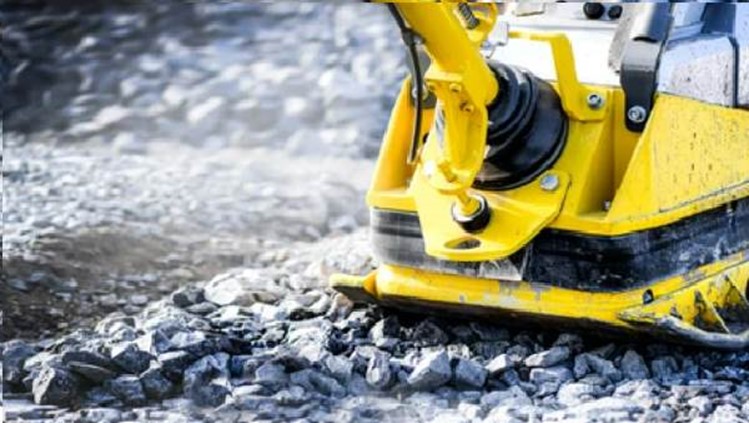Step By Step Guide To Compactor Hire
Compactor hire is one of the most popular choices by many construction businesses and DIYers throughout the UK. If you have never hired a compactor or are considering adding one to your arsenal of equipment you hire, then you are in the right place.
In this resource, we will take you through absolutely everything you need to know about compactor hire and how to get your hands on one. We will compare types of machines and discover the correct application for your project. Whether you are an experienced or novice operator of these machines, this article may just save you money in the long run.
So where do we start when it comes to compactor hire?
Why Compactor hire?
Why should you hire a compactor in the first place? Compactors are pieces of machinery that assist in forcing particles of material or earth closer together to increase their stability. Different materials require various amounts of compression depending on the specific project’s ground capacity requirements. For example, larger compression rates equal heavy load-bearing surfaces.
It is important to note that over-compression casues it to be weakened. Therefore, taking note of your pressure rate and compacting layers is essential.
Type of compactor you can expect to hire
If like many others, when we scour the internet for a product, lots of different designs, types, models and brands come up. Which, if it is not an area you are overly familiar with, can be a bit of a mind-boggling experience. Nonetheless, despite all the different brands and sizes, there will be a common theme you will discover.
There are generally three different styles or types of compactors to hire, these are:
- Plate Compactor
- Rammer
- Roller
Plate compactors
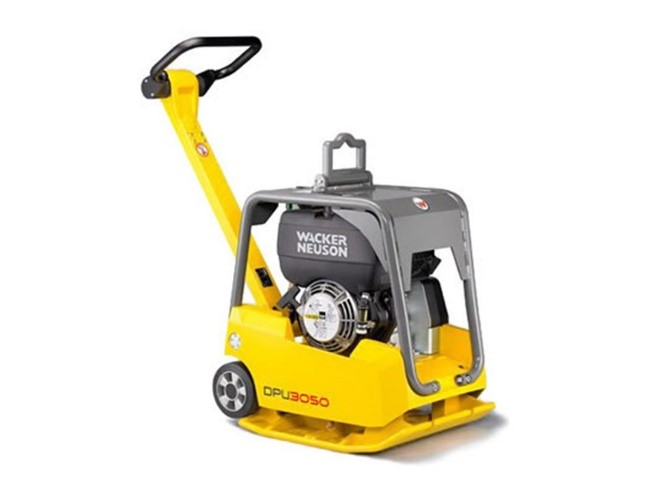
A plate compactors design is ideal for small applications such as patios, small driveways, pavements, etc. These compactors are very versatile, as they can be used in the tightest of spaces. They consist of an engine, a steering handle, and a vibrating plate. The weight of the compactor, including the admitting vibrations, causes the surface to compact as it passes over it.
The vibrations of the plate cause the machine to pull itself along with operators only needing to guide it in the correct direction.
Rammers
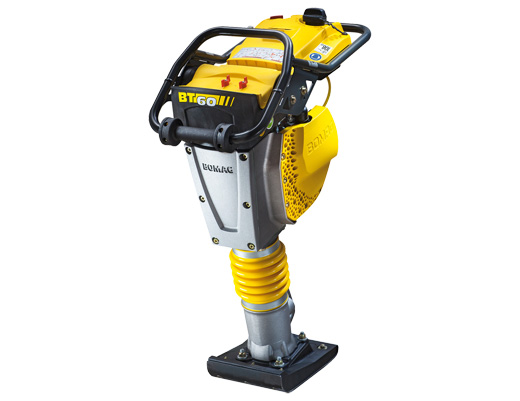
These machines are completely different from plate compactors. However, they deliver compaction in the tightest of spaces. Trench rammers are suitable for confined spaces such as trenches, indoor work, and often for small compaction projects. These machines are handled by one operator and weigh around 25kg (manufacturer dependant).
These machines consist of an engine unit and a compacting foot. The engine powers the foot, which generates a downward ramming motion, compacting the surface. Operators control the machine with the handlebars provided.
Rollers
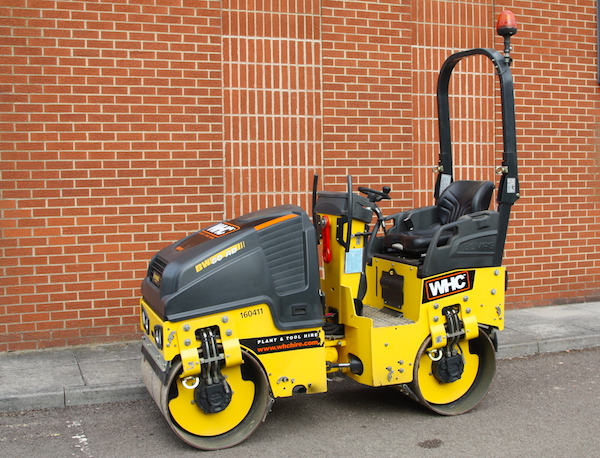
Compacting rollers come in several shapes and sizes. From pedestrian to large road rollers. These types of compactors have been designed for the largest applications. If you have a big area to work with and access allows, choosing a large compact is always the most productive choice. These machines are ideal for compacting building sites, roads, and big driveways.
Rollers consist of one or multiple steel drums which offer downward pressure and vibrating technology. This allows them to maximise their force. Some machines you can drive, while others require operators to walk behind to control them.
Factors you should consider for compactor hire
When choosing the right compactor to hire, it is important to not overspend, but also get equipment that will provide you with adequate assistance. Therefore, by considering the following factors, you will be able to find the most productive piece of equipment for your project.
- The size of the area you are working with
- Access
- Type of material or earth you are working with
- Material import timings
Size of the area you are working with?
The first factor worth considering is the size of the area that you are working on. The larger the area you need to cover, the bigger the machine you require. Larger machines can cover more at once time, generally taking fewer passes to correctly compact. Choosing too smaller a compactor will only end up slowing you down.
Access
Every project is different, and sometimes the amount of access you are working with can determine the size of machinery you can use. For example, a compactor used in the construction of a patio in an enclosed rear garden will be limited by your ability to get it around or through the house. Compared to working roadside or on an open building site, where there is far much more room. Before hiring a compactor, always assess your entrance and exit points to avoid choosing the incorrect machinery.
Types of material you are working with?
Depending on the material or earth you are working with will determine the type of compactor you need. For asphalt, hardcore and granular soils, a vibrating compactor works best. However, if you work with materials or earth that hold a more cohesive nature like silts and clay, an impact compactor is preferred. Choosing the correct type of compaction is essential to the quality of your project. If you are ever unsure, then always consult with your hire professional.
Material importing timings
On larger projects, the timings of materials can determine the size of the equipment you use. Some materials need to be laid out as soon as they arrive. This means you may need multiple machines to keep up with the number of materials that are being offloaded at one time. Always coordinate closely with your suppliers to prevent you from becoming overrun.
Compactor hire cost
The cost to hire a compactor is determined by the machine’s size, type, technology, age, and where you hire the machinery from. Compactors can range from £46.50 + VAT per week to £176.32 + VAT per week. Specialised compactors can, however, cost much more. For more information about the compact hire cost, check out our other hire resource here.“ For the most up-to-date prices, you should always enquire directly with your supplier.
What do you need to hire a compactor?
Hiring a compactor is quite a simple process. If you haven’t already seen our guide to finding the “right equipment hire company to work with,” then we recommend checking this out to help you vet out a supplier.
Once you have found your ideal prospect, you can contact them to organise the collection or delivery of the machinery. You need to complete a hire contract form and pay a security deposit to secure the machinery. Security deposits are paid on the day the machinery is collected or before delivery takes place. This is a safety deposit in case the machinery is damaged or stolen while in your possession. Your security deposit is refunded on the return of the machinery.
Additionally to security deposits, it is always best to insure the machinery while it is in your possession. The last thing you want is to have to fork out for a brand-new piece of equipment because you failed to take out a temporary cover. Not all business insurances cover plant and tool hire, so never assume that this is the case. Always check.
As a minimum, you will require two forms of identification to hire a compactor on a cash (pay-as-you-go) account basis. Alternatively, you can open a trade account which is invoiced to you at the end of every month. Opening an account requires copies of your public liability insurance that state you can cover the hire equipment.
At this stage, you should be all ready to go to receive or collect your equipment.
Transporting your hired compactor
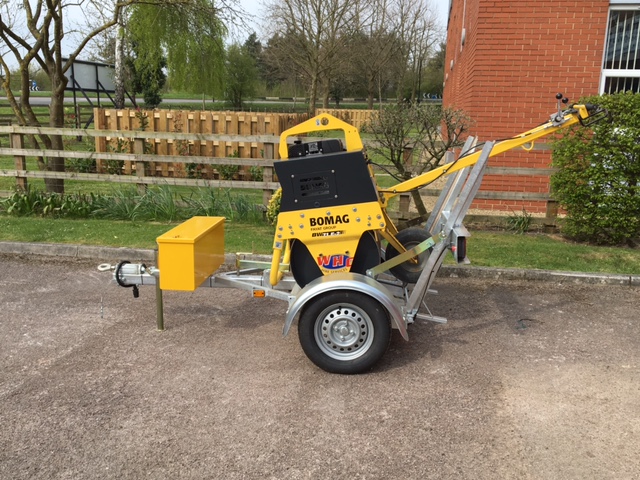
One of the most popular questions we get asked is “can a compactor fit in my car when I collect it?” To help guide you on best practices for transporting a compactor, you can use the following information to help:
Vibrating plates
Vibrating plates are small enough to fit in the back of a hatchback car, however, weigh more than 50kg. This means that two people are required to safely place the compactor in and out of the vehicle. You should always adopt the correct lifting position to prevent injury while lifting.
Trench rammers
Trench rammers are small enough to fit in the back of a standard hatchback car. These machines are light enough to be handled by one person. Again, adopt the correct lifting technique to prevent injury when lifting.
Pedestrian rollers
These large single drum rollers weigh over 150kg and are too large to fit in the rear of a standard hatchback car. These machines need to be secured safely to a towable trailer, which your supplier can offer. Always enquire beforehand about trailer availability. If you are not confident enough to tow the machinery, then organising delivery is your next best bet.
Double drum ride on rollers
Double drum ride-on rollers can weigh anything over 2 tonnes. This means they cannot fit in the rear of a car and need to be transported on a towable trailer or on the rear of a beavertail 26T truck. Your hire specialist will be able to provide you with the best means of transport depending on the machine you require. (Subject to machinery weight)
How to use a plate compactor
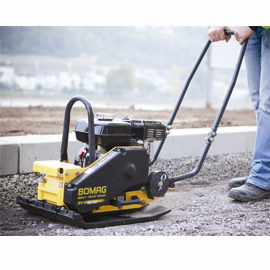
Now you have got the compactor to where it needs to be, you are going to need to know how to use it. If you haven’t used a piece of machinery beforehand, your hire professional will give you a run-through of how to operate it correctly. Every compactor design is different; therefore, never be afraid to ask if you are even slightly unsure.
Ensure you are wearing the correct safety equipment
Like when working with any type of equipment, you should always protect yourself when operating it. When using a compactor, you should protect yourself with safety boots, dust mask, ear protection, goggles, gloves and when operating ride-on machines, a safety helmet.
Note it is extremely important that you monitor the use of vibrating equipment, as long-term periods of exposure can lead to permanent damage. If the equipment has been supplied for you, your employer should have in place a system to protect you from HAVS (hand and vibration syndrome). For more information on testing and monitoring services, please contact WHC Hire Services.
Get the machine into position
Before starting the compactor, you should position it correctly beforehand. With compactor plates and trench rammers, you do not need to start the machine to do so. With pedestrian and ride-on rollers, you can start the machine without using vibrational technology to position it correctly.
Work in Strips
Now you are in position, it is time to begin compacting. Turn on the machine’s engine or engage the vibration on the machine. Then guide or drive the machine in a straight strip over the surface that you are working on. Take your time and let the machine do the work, guiding it with two hands or via the steering wheel.
Turning
Once you have made your first pass over the surface, then you will either need to turn the machine or engage the reverse gear to return to make your second pass. This needs to be parallel and slightly overlapping your previous one. Complete the same method until your whole area is covered and you reach the required compaction rate. This may take multiple passes.
Turning off the machinery
When you have reached your required compaction rate then you will need to disengage or turn off the compaction. The machine is then ready to be removed from the surface area you require. It is important to ensure that the machinery is switched off when transporting off your surface area to avoid damage to other surfaces.
How much should you compact at one time?
There are times when the amount of material that you are importing to your project needs to be layered to reach the desired height. You should work in layers of no more than 50mm at a time to ensure the correct compression rate.
If you choose to work in deeper layers, you will only compromise the stability of the surface. This goes for all types of materials and earth types.
How to return a compactor you have hired?
So, we have given you a full rundown of how to get your hands on a compactor, how to use it and what the cost of doing so might be. But how do you return the machinery, or “off hire the machinery?”
Off-hiring means in simple terms means you are finished with the machinery, and you wish to end your hire agreement. The correct procedure to off-hire a compactor will be written in the terms of your contract. If the machinery needs collecting, this is normally arranged within 24hrs; otherwise, you can return your hired compactor at any time to your supplier.
Once you have off-hired the machinery, you cannot use it again. You could be in breach of your hire contract agreement if you do so, leading to additional charges.
To avoid any unnecessary additional charges, always return the machinery clean and full of fuel.
Help with compactor hire
If you are looking to hire a compactor for your project, then WHC Hire Services could help you. With state-of-the-art equipment from BOMAG and Wacker Neuson, our service provides solutions to all project sizes. With regular investments in the quality of our fleet, we offer the latest equipment at competitive and affordable hire rates. Click the link below to view our full range of rollers and compactors available to hire for commercial and DIY projects. Or call 01684377977 today for more information or arrange your hire.

